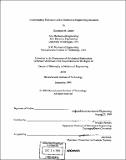Understanding estimation and its relation to engineering education
Author(s)
Linder, Benjamin M
DownloadFull printable version (4.922Mb)
Other Contributors
Massachusetts Institute of Technology. Dept. of Mechanical Engineering.
Advisor
Woodie Flowers.
Terms of use
Metadata
Show full item recordAbstract
A wide variety of engineering activities benefit from the use of rough estimates of the type commonly referred to as back-of-the-envelope calculations. These include evaluating the feasibility of an idea, planning experiments, sizing components, and setting up and checking detailed analyses. The overall goals of this thesis were to understand how people make rough estimates for physical quantities and to understand how that activity relates to undergraduate engineering education. The specific objectives of this thesis were to describe the nature and extent of mechanical engineering students' estimation capabilities, to develop a framework describing estimation activity and to characterize the relationship between rough estimation activities and learning activities. The intent of these objectives was to develop conceptual knowledge useful for assessing and teaching rough estimation skills as well as for guiding estimation activity in practice. Students were found to have considerable difficulty making estimates for common engineering quantities, such as force and energy. Students were also found to have difficulty applying basic engineering concepts in rough estimation situations even at the senior level. In order to identify concepts that give students difficulty, a new assessment method based on students' ability to associate correct units with common engineering quantities was developed. The mediated action framework that was developed consists of three components: effective actions people take when they make estimates, mediating characteristics and the resulting limitations imposed on these actions, and compensation methods people use to circumvent these limitations. The primary focus of this thesis was on identifying the effective actions. A set of effective actions was identified that was sufficient to describe a large number of people's solutions to a variety of estimation problems. The relationship between rough estimation and engineering curricula was examined by comparing rough estimation activities in practice and learning activities in curricula. Rough estimation activities were found to be incongruent with typical undergraduate engineering curricula. The differences between these activities suggest ways in which curricula might be changed to improve students' estimation skills.
Description
Thesis (Ph.D.)--Massachusetts Institute of Technology, Dept. of Mechanical Engineering, 1999. Includes bibliographical references (p. 86-87).
Date issued
1999Department
Massachusetts Institute of Technology. Department of Mechanical EngineeringPublisher
Massachusetts Institute of Technology
Keywords
Mechanical Engineering.